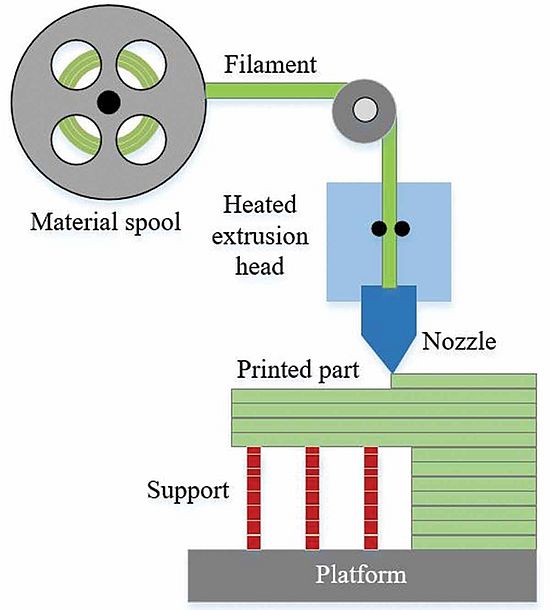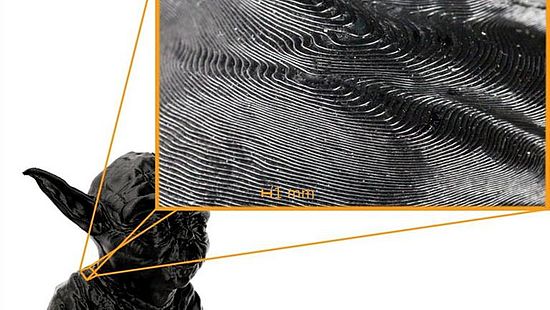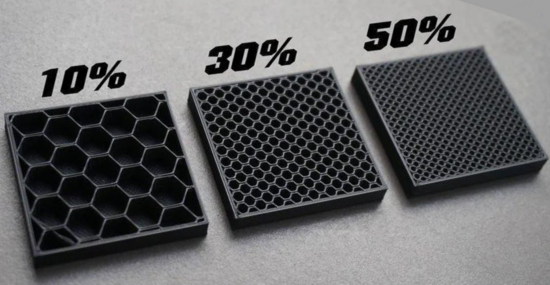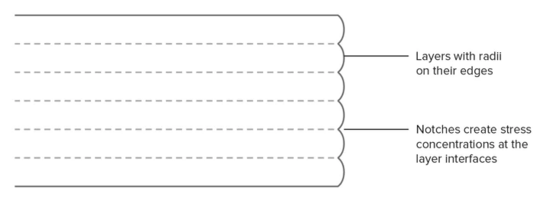
What is the FDM 3D Printing Process?
"Fused Deposition Modeling," abbreviated as FDM, translates to "melted layer construction"
in a loose sense. FDM is one of the oldest and simplest 3D printing technologies. FDM-
produced parts are characterized by a distinct layered structure. "Fused Deposition Modeling"
is a registered trademark that has established itself in the market, while a more neutral term
for the same technology is "Fused Filament Fabrication" or FFF.
How Does FDM 3D Printing Work?
The 3D model of a component is loaded into a "Slicing Software." In this program, the
machine code is generated. The component is divided into layers of 0.1-0.3 mm thickness.
The toolpath of the print head is then automatically generated. The print head "draws" the
outer contour of the component and fills in the areas that should be solid. The software
creates a file that includes the toolpath of the print head and other information, such as the
required melting temperature of the material. The finalized code is sent to the 3D printer.
A plastic wire, known as filament, is fed into the print head as the printing material. The
filament is heated to the preset melting temperature, causing it to become viscous. This
precise temperature control ensures that the applied material does not flow away and hardens
within seconds of application. The viscous material is pushed through the print head by the
incoming material. This process is precisely calibrated to the motion of the print head,
ensuring an even material line is laid down. This continues until the layer is complete. Then,
the print head moves upward by the set layer thickness and repeats the process with the data
for the next layer. This creates the typical layer-by-layer structure characteristic of 3D
printing.
If there are overhangs on the component, they appear as steps on the surface. The shallower
the angle deviates from the xy-plane, the more visible and longer these steps become. Due to
the horizontal deposition of layers, overhangs greater than 45° require support material
during printing. The supports are programmed and manufactured by the slicing software,
creating a foundation for the layers. Printing complex shapes is possible with water-soluble
materials used for building supports. After printing, the supports are simply rinsed away in a
water bath or manually broken off.


Good to know

Infill with Honeycomb Structures
With FDM 3D printing, it's possible to create a closed cavity. FDM parts are usually not
manufactured as solid models but rather with a so-called "infill" of 20-30% of the volume.
Internally, the parts consist of honeycomb-like structures.
Real Materials in the FDM 3D Printing Process
Furthermore, all materials are applied "unadulterated" through melting, allowing the direct
use of well-known engineering materials. Most thermoplastic materials are suitable for FDM
printing, enabling the utilization of a wide variety of injection molding materials for 3D
printing. Other 3D printing processes often use "related" materials that have similar or
approximate properties to the desired material.

Tensile and Shear Strength
The layers of the printed part are visible to the naked eye, and the strength in the build
direction is determined by the adhesion between the layers. Consequently, strength decreases
in the build direction. This is because the bottom layer has already fully solidified while the
next one is being printed. Therefore, it only partially melts into the last layer. This results in
the tensile and shear strength of the part in the build direction being only about 40% of the
tensile strength of the part in the x/y-direction. As surfaces are made up of adjacent material
paths, there is also a reduction in tensile strength. Therefore, FDM parts have only about 70%
of the tensile strength of the actual used plastic material.
Why Choose FDM?
The decision to employ FDM technology for your project can be a game-changer. It offers a
unique blend of precision, versatility, and affordability, making it suitable for various
industries and applications.
FDM technology finds applications across various industries. In aerospace, automotive,
healthcare, and consumer goods, FDM is used for rapid prototyping, tooling, and end-use
parts production. Understanding the specific needs of each application helps maximize the
benefits of FDM 3D printing technology.
In the world of 3D printing, Fused Deposition Modeling (FDM) stands as one of the pioneers,
shaping countless innovative endeavors. Beyond the core features outlined in the technology
explanation, let's delve into specific applications and why FDM might be the perfect choice
for your project.
Applications:
Revolutionizing Healthcare:
FDM has found its place in healthcare by facilitating the
creation of custom medical devices, patient-specific implants, and lifelike anatomical models.
Surgeons rely on these 3D-printed models for surgical planning, providing a level of
precision and understanding that traditional methods can't match.
Application in Aerospace:
FDM is the unsung hero of aerospace innovation. Engineers use
it for rapid prototyping of complex components, allowing them to validate designs quickly
and cost-effectively. From lightweight drone parts to intricate aircraft interiors, FDM's
versatility is a crucial asset in the aerospace industry.
Educational Excellence
FDM technology transcends industries and finds a significant role
in education. It empowers students and researchers to explore concepts hands-on, promoting
STEM education and fostering innovation in academia.
Empowering Automotive Engineering:
In the fast-paced world of automotive design, FDM
accelerates the creation of functional prototypes and specialized tooling. Manufacturers rely
on FDM to optimize vehicle performance and safety, resulting in more efficient, safer, and
aesthetically pleasing cars.
Consumer Goods Redefined:
From personalized consumer electronics to ergonomic kitchen
gadgets, FDM is at the heart of creating products tailored to individual needs. Its cost-
effectiveness and quick turnaround make it an ideal choice for product designers aiming to
bring their ideas to market rapidly.
